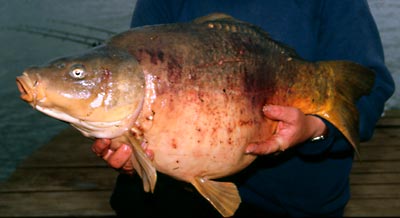The disease can kill fish in their thousands but, although highly contagious, it offers no risk to people. It affects common carp and its ornamental varieties, as well as other species including goldfish, tench, pike and Wels catfish. Woodland View has four pools and a farm for stocking purposes and the Department for Environment, Food and Rural Affairs (Defra) has prohibited the movement of any fish to and from the venue. It could be three years before the prohibition can be lifted for the venue has to test negative for SVC for that long, although this period could be shorter if a programme of clearance and disinfection is successful. Weymouth, Dorset fish Health Inspectors are trying to discover the source of the outbreak and are concerned about any fish that could have been in contact with those in Woodland View. Symptoms of SVC include abdominal swelling, darkening of the skin, swollen eyes, pale gills, trailing faecal casts and protrusions of the anus. The classic symptoms of unhealthy carp nearly always involves a period of lethargy prior to their death, this may last for a period of a few hours to a few days. The usual place to find these fish is in the margins in areas of cover, such as reed stems, overhanging trees etc, although many may stay out in the lake sulking in weed beds and around islands. Just before death the fish are usually found sitting on the lake bed or propped up between vegetation and will lie almost motionless. Sick fish may display no obvious external symptoms although they may shows symptoms such as heavy mucus production, open lesions, darkened skin, gasping, etc. Infected fish may be lethargic and show areas of bleeding in the gills and skin before dying within 10 days. If anglers observe carp dying or displaying these symptoms they should call the local Environment Agency Fisheries office or the national emergency hotline on 0800 807060. |
Welcome!Log into your account











